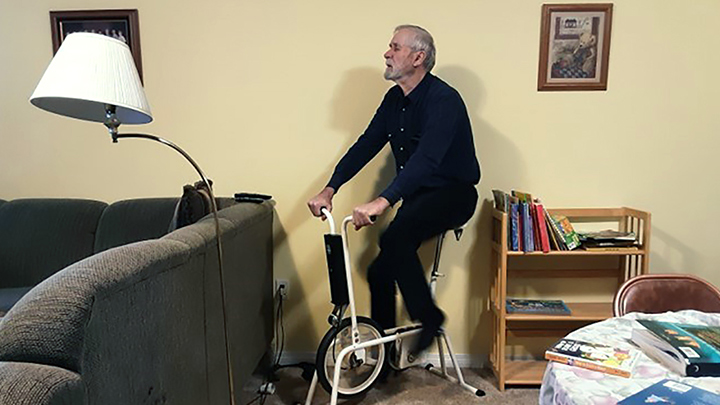
February 29, 2024

Lowell Bauman enjoys staying active with a ride on his stationary bike. After having his regular bloodwork done, as well as a cardiovascular disease (CVD) risk assessment, he discovered he’s high-risk for CVD. “I had no family history of heart disease or hypertension and I’m a non-smoker. But it was still good to be able to check my risk with my bloodwork.” Enhanced Lipid Reporting calculates various factors that increase an individual’s risk for heart attack and stroke, using information such as blood pressure, family history, chronic disease treatment and tobacco use. Photo supplied.
Story by Vanessa Gomez
It’s no secret that check-ups with a primary care provider can give you the head start you need to make changes to protect your health and well-being.
At his check-up, Lowell Bauman, 72, had regular bloodwork done, with the addition of the cardiovascular disease (CVD) risk assessment, which checked his cholesterol and risk for heart attack and stroke.
“I had no family history of heart disease or hypertension and I’m a non-smoker,” says the Spirit River resident. “But it was still good to be able to check my risk with my bloodwork.”
Enhanced Lipid Reporting (ELR) calculates various factors that increase an individual’s risk for heart attack and stroke, drawing upon information such as blood pressure, family history, chronic disease treatment and tobacco use.
“This benefits my practice by saving me time when calculating a patient's Framingham Risk Score (FRS),” says Dr. Deanna Funk, Bauman’s physician. “I use FRS when deciding whether initiating a statin — a drug to help lower cholesterol is recommended based on the most recent evidence.
“Enhanced Lipid Reporting is also helpful when counselling patients as it shows the different factors that contribute to their FRS and what they can do to decrease their risk of poor outcomes.”
The test identified that Lowell is living with a high CVD risk — and Dr. Funk took the opportunity to discuss ways he could reduce his risk.
“It’s important to explain a patient’s results in a way that makes sense to them. Numbers and lab results are meaningless, but showing them how lifestyle changes and medication can impact their outcomes is highly motivating.”
Bauman adds: “I was surprised to see how medication (statin) could reduce my risk of a heart attack or stroke. My doctor explained it in a way it made sense and I knew exactly what I needed to do.”
Dr. Funk says: “ELR is beneficial to physicians and patients allowing us to focus on working together to improve health outcomes as early as we can and minimize the risk of heart attack and stroke much earlier. It’s easy to complete and convenient.”
Bauman now takes statin daily and gives physical activity a high priority.
“I hope the medication I’m taking is making a difference. I want to be as active as I can and for as long as I can. I’ve enjoyed incorporating walks and biking into my daily routine. I also took a course with a dietitian and I’m trying to eat healthier. I’m happy to do all I can to stay healthy.”